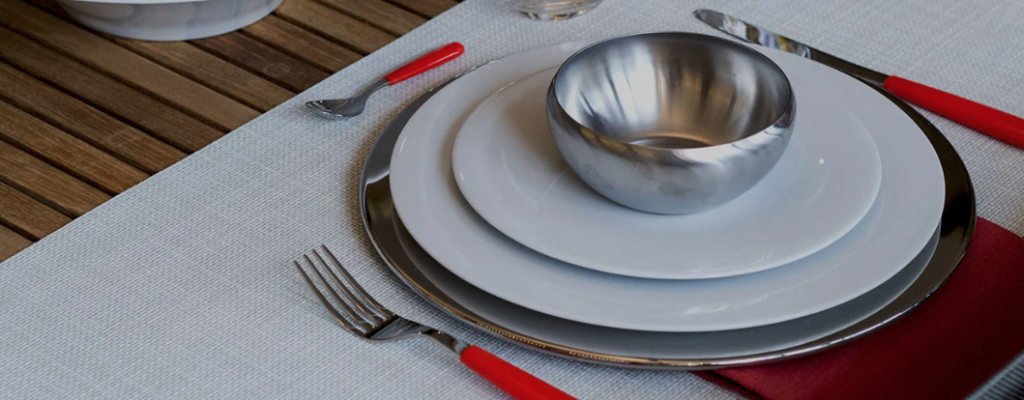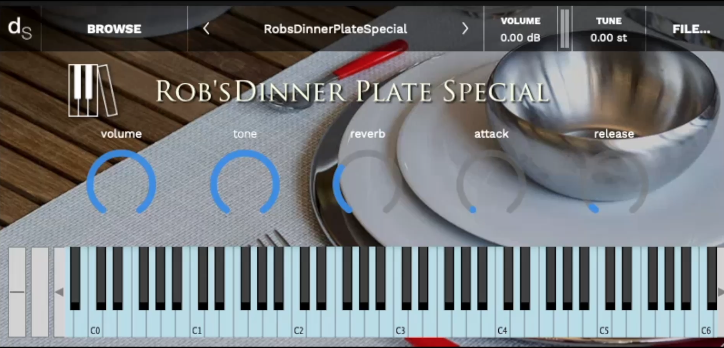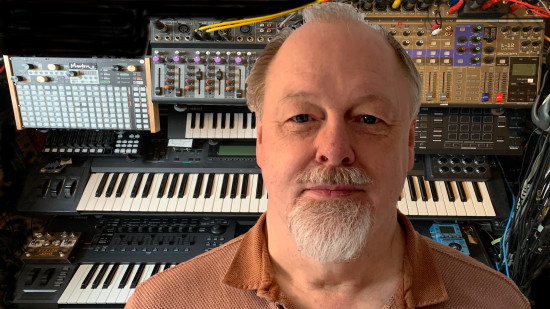
The story
While hand-washing the dishes the other evening I inadvertently flicked a dinner plate with my finger and to my surprise, I heard a tone. I really shouldn’t have been too surprised because as I noted in the description above, “music is everywhere”! Naturally, I had to record what I heard to see if it might become an instrument I could use. The natural resonance is midi 59 but the tone had very little sustain so in order to create sustain, I also sampled a tuning fork (midi 57), pitched it up to midi 59, moved it around the mic to create a bit of a tremolo effect, then laid the “Fork” track just under the “Dinner Plate” track to give me a full ADSR sample which can now also be modified by you using your plugins. There’s a bit of harmonics on the high end but I found that attractive as well. It sounds to me like a very unusual electric piano – not a Rhodes, or a Wurli – but something new – Enjoy!
Rob's Dinner Plate Special
Interface

Reviews for Rob’s Dinner Plate Special
- Sound
- Character
- Playability
- Inspiration
- GUI
Leave a review to let others know what you thought of the instrument!
An unexpected dreamy mallet!
While this is just a one-sample instrument based on a simple metallic bowl hit, it is made in a way that once you play it, you experience all the goodness. It's an unexpected melancholic feeling, a mellow hit that gives you instant feels. The simplicity surrounding it is the basis of perfection. It doesn't need anything else. Just try it yourself!
A fun name for a fun pack
I love the story behind this pack. It’s amazing that, with a little effort and a bowl, such a good result has been achieved. The sound quality is very decent.
I would have liked to see a delay control and a lowpass control, but, in general, the ones provided are more than adequate.
Music IS everywhere!
Forget GAS. Sample Acquisition Syndrome (SAS) is much worse. There's something about being able to turn just about anything into a musical instrument that is very addictive.
Rob definitely seems to be affected. I would say that anyone with more than 10 sample packs on Pianobook.co.uk is a candidate, and he has 14! Luckily for the rest of us (even fellow SAS sufferers like myself), this means that the missing 'Anything' category gets even more instruments for people to enjoy! 'Other' is just so dismissive!
The tuning fork technique isn't one I have seen before, and it seems to have been very effective - so I suppose that this makes it a hybrid instrument: dinner plate and tuning fork. Whatever the source, it is the end sound that matters, and this is, as Rob says, not a Rhodes or a Wurli, but it sounds to me like some long-lost cousin from far away.
There's a kind of bell-like character to the sound, which takes it away from the purity of a conventional electric piano, and moves it ever so slightly towards something more metallic and percussive. But it isn't a glockenspiel at all - there's none of that brittle timbre. In fact, it's a lot like...a dinner plate!
I can't resist looking at samples and examining XML files, and there's a lot behind the scenes here. The basic sample lasts for over 18 seconds, and the length has been cut back so that you only get some of that - thereby excluding some audio artefacts in the latter half. I, of course, edited the XML so that you got the whole experience, and 18 seconds is a long time! It looks like Rob was playing with looping the sound, and that would have been my approach as well. As it is, there's at the dinner plate at the start, and then a long sustain portion.
I edited the XML to give full ADSR envelope capabilities, and this showed that programming is not always the answer - all I got for my efforts was a little bit of control over the envelope, but the original still sounded better. The 'Tone' control might benefit from a bit of translation table adjustment - as it is, the active range is in the lower quarter of the range of the rotary control.
The Attack and Release envelope controls do provide something that you don't get on many electric pianos - slow in and out times. Suddenly, what might have been an electric piano's uncertain cousin turns out to be more closely related to singing bowls or glasses, but without all that finger-dipping, constant movement, and that riding of resonance to maintain the sound. If this had been me, I would have forgotten the percussive roots and totally gone for 'Rob's Singing Dinner Plate Special!' Mega!
In summary then, never assume that you have run out of things to sample. Inspiration may strike you at any time - as you clear up after dinner, perhaps! The singing variant has to be my favourite, but the 'not quite en electric piano' variant has its uses too - especially when the expected sound would be E.Piano. This isn't that at all, and so much the better for that!



